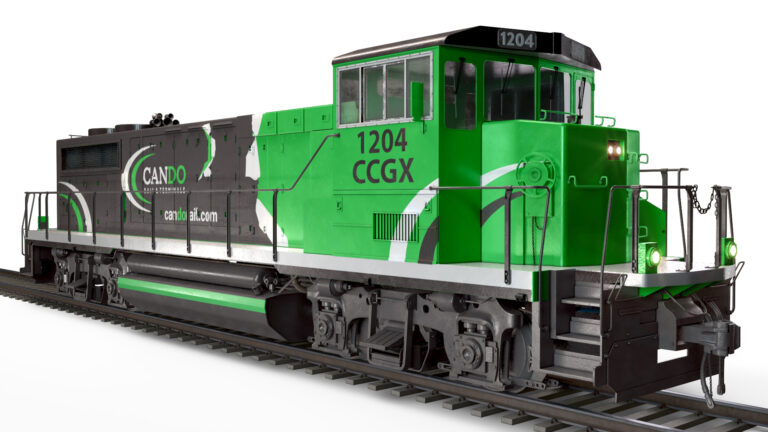
EDMONTON, Alberta — Cando Rail & Terminals — the Canadian company which operates shortlines, terminals and transload facilities, and handles industrial switching, among a wide variety of rail services — will develop a battery-electric switcher.
The company announced Thursday that it plans to retrofit a legacy, non-tier compliant diesel with a lithium-ion propulsion system for use in yard or closed-loop switching. The locomotive will be able to perform work normally handled by a diesel switcher, saving fuel and reducing greenhouse gas emissions. Once the retrofit is complete, the locomotive’s performance will be evaluated in service in the Fort Saskatchewan, Alta., area.
The Government of Alberta is committing C$2 million to the C$4 million project through the Emissions Reduction Alberta Industrial Transformation Challenge, the same program that has helped fund CPKC’s hydrogen fuel-cell locomotive program [see “CP to build additional hydrogen locomotives …,” Trains News Wire, Nov. 1, 2021].
Steve Bromley, chief commercial officer at Cando Rail & Terminals, said in a press release that the government funding “is critical to help Cando Rail & Terminals develop a battery-powered locomotive customized for industrial switching operations. This industry-transforming initiative could drastically reduce greenhouse gas emissions, helping rail service providers and industrial companies moving product by rail meet sustainability goals faster.”
The government participation followed an independent review by a team of experts in science, engineering, business development, and other fields, followed by a final decision by the ERA board of directors based on the recommendation of those experts.














From rendering it looks like a EMD GP-38 with an ALCO C 415 cab on it.
Great idea but,
“About 89% of electricity in Alberta is produced from fossil fuels– approximately 36% from coal and 54% from natural gas. The remaining 10% is produced from renewables, such as wind, hydro, and biomass.”
Source; government of Canada
Maybe in Quebec Ontario or New Brunswick where the grid is clean but still need fossil fuel in Alberta to produce the power to charge the batteries.
Electric switchers are more efficient than diesel in switching service. The diesel engine is always operating even when stopped, coasting and braking which is not the case for electric switchers. The electric switcher can regenerate power from the braking process. An electric plant uses fossil fuels more efficiently than a diesel.
Battery electric switchers are worthwhile even when the electricity comes from fossil fuel plants. The power grid is getting cleaner all the time.
“An electric plant uses fossil fuels more efficiently than a diesel.”
Tell that to all the climate change freaks and see what they say!
The timeline for the Cando’s new switcher project:
* October 2023 : Finalize Li-Ion system + charger requirements and source material
* March 2024-September 2024 : Retrofit locomotive/commissioning
* October 2024-December 2025 : Field testing.
Dr. Güntürk Üstün
And how are they going to recharge the batteries? No one ever answers that question.
This technology is still under development and is not available in Canada at the current time. Cando Rail & Terminals are working with US-based Innovative Rail Technologies (IRT), who is already developing and retrofitting Li-Ion propulsion systems in the US and is currently demonstrating one of the first commercially available Li-Ion switching locomotives in the US. Cando will continue to work with Canadian suppliers and innovators with the goal that our pilot project will position Alberta, and Canada, to become a leader in the technology.
Dr. Güntürk Üstün
The related technology has a large potential to significantly reduce emissions in switching operations across North America. The market and value proposition for a Lithium-Ion battery powered locomotive is exceptionally strong. Cando Rail & Terminals estimate that there are approximately 10000 switcher locomotives in North America, 2000 switcher locomotives in Canada, and 350 switcher locomotives in Alberta.
Dr. Güntürk Üstün
But still…how much extra fossil fuels will they be burning to create the electricity need to recharge these locos? And what is the range on these locos – how OFTEN will they need to be recharged?
And why is no one talking about nuclear power to generate the electricity?
Good question!